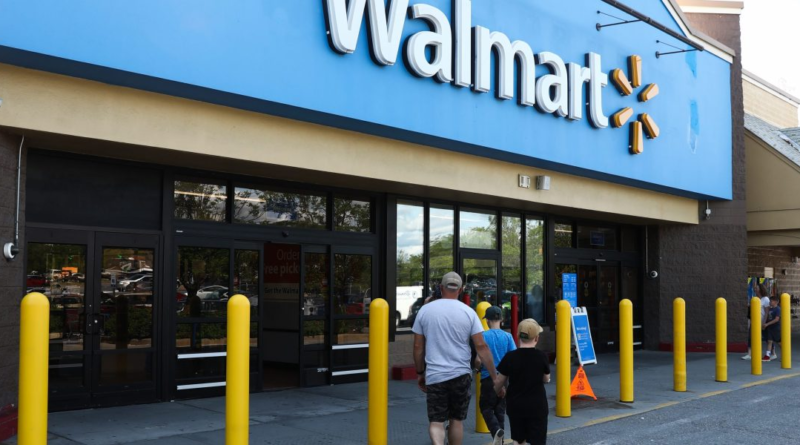Shoppers are in a spending mood. But retail executives point to inflation and depleted savings as signs the good times won't last
Americans are still spending. And the country’s biggest retailers are still warning that the party is at risk of fizzling.
Walmart Inc., Target Corp. and Home Depot Inc. all topped Wall Street’s profit estimates in their fiscal second quarters, which ended in late July. In that way, at least, the results reinforced the picture of a resilient consumer after US retail sales data for last month beat expectations, with gains across most major categories.
But there were signs of weakness, too, and retail executives were at pains to share their worries for the rest of the year. Consumers have yet to regain their appetites for big-ticket items and nonessentials, and that dragged down sales at Target and Home Depot despite their better-than-expected profits. In addition, executives warned that new pressures such as rising interest rates and student-loan repayments could take the wind out of consumers’ sails during the second half.
“Jobs, wages, and pockets of disinflation are helping our customers,” Walmart Chief Executive Officer Doug McMillon said Thursday on a call with analysts, summing up the dueling economic forces on his customers. “But rising energy prices, resuming student loan payments, higher borrowing costs, and tightening lending standards — and a drawdown in excess savings — mean that household budgets are still under pressure.”
Indeed, excess savings from the pandemic and higher wages in a historically tight labor market have been fueling purchases for a while. But consumers have increasingly turned to borrowing as savings wind down — just as credit tightens. Wage growth has slowed from the peaks of last year. And the student-loan repayments that McMillon is worried about will resume in October, hitting the spending power of millions of households.
That’s also a big risk for Target, where signs of a less exuberant consumer were perhaps clearest. The retailer’s sales fell the most in almost seven years as demand slid in such categories as apparel, home goods and hardlines, a category that includes electronics and toys.
Despite a strong profit performance in the second quarter and robust sales of food and beauty products, the Minneapolis-based company cut its earnings forecast for the year as a whole and emphasized prudence in its outlook.
“The consumer is still taking a very cautious approach to discretionary spending,” Chief Operating Officer John Mulligan said on the earnings call.
At Home Depot, total transactions declined and sales of big-ticket items — think patio sets and major appliances — were soft. CEO Ted Decker said “fears of a severe recession have largely subsided,” while acknowledging that some shoppers shifted more spending from goods to services in the wake of the pandemic.
Early Doubters
This isn’t the first time retailers have doubted the consumer. In the first quarter, executives and economists anticipated a pullback that — so far — hasn’t happened at a large scale. In fact, Walmart said the back-to-school season is off to a solid start, which usually bodes well for the holiday shopping season.
Certainly, retailers might just want to set investors’ expectations low so they can beat them later. Despite their cautious comments, the consumer could continue surprising to the upside.
Sentiment has improved overall since June as a strong labor market and lower inflation expectations boost optimism, according to an index from the University of Michigan. Consumers are still spending money on services including restaurants and plane tickets. And despite the dip in credit cards, consumers overall borrowed in June by more than forecast as they continued — for now — to tap loans for cars and tuition, according to Federal Reserve data.
The economic backdrop has changed in key ways since earlier this year, though. Credit availability has tightened, not just following the collapse of Silicon Valley Bank in March, but also as banks get more cautious amid recession risks later this year or in 2024.
Credit card rates have surged to about 22%, according to WalletHub. Despite a gain in overall borrowing in the Fed data, outstanding revolving credit, which includes credit cards, fell for the first time in two years. That’s a sign that sky-high rates are giving consumers pause.
Job Market
There’s also evidence that consumers are looking for bargains. Off-price retailers TJX Cos. and Ross Stores Inc. both reported better-than-forecast same-store sales growth in the second quarter and strong outlooks for the remainder of the year.
Mortgage rates have increased, with the average 30-year contract soaring to 7.09% this week, the highest since 2002. That’s crimping any extra spending by home buyers. And Americans’ excess savings since the start of the pandemic are expected to be depleted by the end of the third quarter, according to a report from the San Francisco Fed.
The labor market has underpinned Americans’ optimism and spending, with unemployment at a multidecade low in July. But payroll gains are slowing and wage growth, which is still high by pre-pandemic standards, has weakened by nearly half since 2020 to a 4.4% pace in July.
Then there’s inflation. The pace of price increases is finally easing, which is a relief for consumers even though it’s still stubborn in food and shelter, two major spending categories. But for some companies, inflation has been masking declines in unit volumes as shoppers buy less.
Conagra Brands Inc. said last month that Americans are cutting back on food purchases. There are even signs they’re skimping on everyday basics such as toilet paper and toothpaste.
“Everybody’s waiting for the other shoe to drop on the consumer,” said Lawrence Werther, chief US economist at Daiwa Capital Markets. Tighter credit, a softening job market and less savings will all contribute to a slowdown in consumer spending, he said. “The warnings by corporate executives are well placed.”


